Invasive Species: Clematis terniflora, Sweet Autumn Virginsbower
Sweet autumn virginsbower is an invasive climbing, semi-evergreen, ornamental vine. The leaves are opposite, compound (with three to five leaflets), and the margins are entire. Leaflets are each 2 to 3 in. (5 to 7.6 cm) long. White, fragrant, four-petaled flowers appear in the late summer through the fall. Seeds are also showy, and production is prolific. Seed heads have long, silvery-gray, feather-like hairs attached. The native species (C. virginiana) is very similar (margins of leaves of the native tend to be toothed) but not as prone to self-seeding and spreading. Sweet autumn virginsbower prefers sun to partial shade and is found invading forest edges, rights of way, and urban green space especially near creeks. It is native to Japan and China and was introduced into the United States as an ornamental plant.
What are invasive species and why should we be concerned about them?
Taxonomy: Scientific and Common Names for This Species
Ranunculales > Ranunculaceae > Clematis terniflora DC
Synonym(s): leatherleaf clematis, yam-leaved clematis
Clematis terniflora – USDA PLANTS Profile
Distribution Maps
Sweet autumn virginsbower – The reported distribution of this invasive species across the United States. (Source: Invasive Plant Atlas of the United States)
Up-to-the-minute distribution maps and why they are important
Reporting This Invasive Species
What is the best way and place to report the occurrence of an invasive species?
How to report an invasive species sighting to EDDMapS – Early Detection & Distribution Mapping System
EDDMapS – Report an invasive species to EDDMapS
Cooperative Extension Offices – Find your local Cooperative Extension office on this map provided by USDA
How to Identify
This invasive species can be identified by looking for the characteristics described in the paragraphs that follow.
Vine
Sweet autumn virginsbower is an invasive climbing, semi-evergreen, ornamental vine.
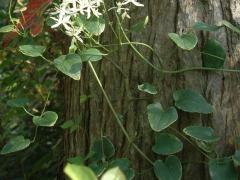 |
 |
| Chris Evans, River to River CWMA, bugwood.org | Richard Webb, Self-employed horticulurist, bugwood.org |
Foliage
The leaves are opposite, compound (with three to five leaflets), and the margins are entire. Leaflets are each 2 to 3 in. (5 to 7.6 cm) long.
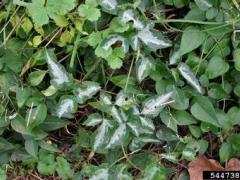 |
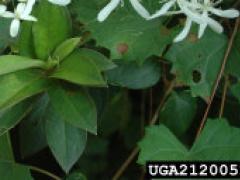 |
| Leslie J. Mehrhoff, University of Connecticut, bugwood.org | Chris Evans, River to River CWMA, bugwood.org |
Flower
White, fragrant, four-petaled flowers appear in the late summer through the fall.
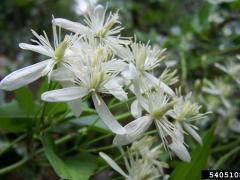 |
|
| Chris Evans, River to River CWMA, bugwood.org | Karan A. Rawlins, University of Georgia, bugwood.org |
Fruit
Seeds are also showy, and production is prolific. Seed heads have long, silvery-gray, feather-like hairs attached.
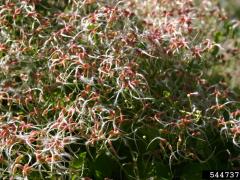 |
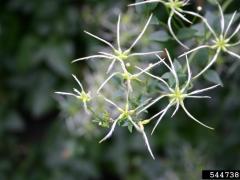 |
| Leslie J. Mehrhoff, University of Connecticut, bugwood.org | Leslie J. Mehrhoff, University of Connecticut, bugwood.org |
Native Species That Resemble Sweet Autumn Virginsbower
Clematis virginiana, devil’s darning needles – Images at invasive.org
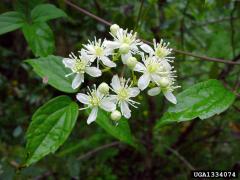 |
 |
| Wendy VanDyk Evans, bugwood.org | John D. Byrd, Mississippi State University, bugwood.org |
Clematis ligusticifolia, western white clematis – Images at invasive.org
 |
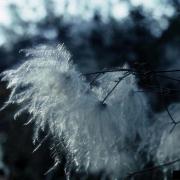 |
|
Dave Powell, USDA Forest Service (retired), |
Joy Viola, Northeastern University, |
Additional Images for Sweet Autumn Virginsbower
Sweet autumn virginsbower – Images at Invasive.org
Learning Resources for Sweet Autumn Virginsbower
Additional Information, Biology, Control and Management Resources
Control and management recommendations vary according to individual circumstances. Location, habitat, weather, and a variety of other conditions are factors that help determine the best treatment choice. To find the safest and most effective treatment for your situation, consult your state’s land-grant institution. If you will use chemicals as part of the control process, always refer to the product label.
United States Land-Grant University System – Find your land-grant university’s College of Agriculture, Cooperative Extension Service, or other related partner on this map provided by USDA.
Clematis terniflora – Missouri Botanical Garden
Invasive.org – Center for Invasive Species and Ecosystem Health
Clematis terniflora – Illinois Wildflowers
Electronic Data Information Source – University of Florida IFAS Extension
Plant of the Week – University of Oklahoma Department of Botany & Microbiology
Sweet Autumn Virginsbower – National Park Service

